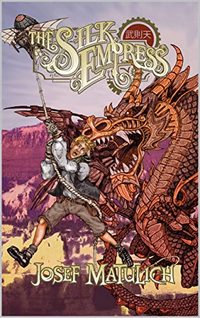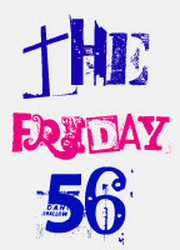This morning, I talked about Matulich’s The Silk Empress and now I’m glad to bring you this Q&A with the author—great answers!
Let’s start off by introducing yourself to the readers—talk about your background, path to publication, etc.
I am a writer/artist that specializes in horror comedy, with a few interesting side-quests like make-up special effects artist and theater tech. My first publication was a humorous think-piece in Science Digest at eighteen. I had various small successes with short plays, RPG games and such until about eight years a small press published Camp Arcanum. Since then, I’ve published four novels through different publishers. When rights reverted for the Arcanum Faire trilogy (Camp Arcanum, Power Tools in the Sacred Grove, & The Ren Fair at the End of the World) I released them myself with Seth Lyons covers. The Silk Empress is my first original indie book released through both Amazon and Ingram. Not willing to just do what I knew I was safely capable of, this project included front and back covers by Seth, plus interior illos by him for each of the chapters. I think I broke my artist.
All authors have more ideas running around in their head than they can possibly develop—what was it about this idea that made you commit to writing it? It’s not like anything else you’ve done—was that part of the attraction?
There was a recurring situation at book events where I sat behind a table full of books suitable for the 16+ crowd filled sex, magick, and power tools and have to tell a 12 year old and his parents that these books really weren’t for them. I decided to write my next book without anything inappropriate for my 12-year-old hero. Several years ago, a local library had the vintage and costume shop my wife and I own present a Steampunk fashion show. The theme was an airship hauling silk from China to Europe and each model was a member of that crew. In my three years of Cancer, Chemo, and Covid lockdown I was able to mesh those two concepts.
Stephen King’s recent comments notwithstanding, let’s talk worldbuilding. In general, and with this book specifically, what’s your approach? Do you sit down and figure it all out ahead of time (setting, technology, culture(s), etc.?) or do you just make up most/all of it on the fly as you come across the need while writing?
I started with the concept of the High Silk Road and the industrial revolution that allowed China to win the Second Opium War and shrug off the colonial powers of Europe. Then the various technologies like the stiffened silk airship hulls, phlogiston, Liu Industries explosives, and karakuri automata were added to the mix. Then I started peppering the map of the old Silk Road with locations and notes while throwing in my revisions to history like the U.S. Civil War only lasting a few months after the introduction of German manufactured airships. Researching the Turfan caravanserai and the Uyghurs I found the perfect place for intrigue and adventure. On top of that, I liberally sprinkled Ship’s Cant, a patois of Chinese, French, and Portuguese, along with a bit of Asian folklore. Some swearing in Mandarin and Scots Gaelic added for taste. Backtracking to add new bits that I discovered ten or twenty chapters in was a constant process.
How do you approach humor in your books? I recall there being a decent amount in Camp Arcanum and there’s plenty here (including jokes that will likely fly above the target audience’s head). Do you work to maintain a balance between it and the action/tension? Does it come naturally? Do you have to come back on a later draft and insert or delete jokes to get it right?
Humor is something I naturally do; it kept me from getting flattened on the school yard and kept me sane in my adult years. The Silk Empress was always intended as a misadventure, which has all the elements of a great boy hero story, but things consistently go horribly wrong. Most of the jokes are baked in from the beginning. The majority of the rewrites involved improving description, character, and narrative. My editor had me remove a few remarks by the 19th century insular boy hero that were fitting for the character, but not acceptable for modern readers.
I don’t have a specific question here, but why don’t we take a moment to talk about finding and working with Seth Lyons—how much (in your mind) did those illustrations benefit the book?
Seth Lyons came to us through our store where we have a large Steampunk costume section, and he had a great collection of his steampunk art prints we carried. When I republished The Arcanum Faire books, he and I got our heads together for the covers. The original small press covers I had given specific input to the artist and the result was disappointing. With Seth, we got together at a Chinese restaurant and went over characters and visual elements, and then I let him run amok. The results were far superior. We did the same for Silk Empress, producing a great front and back cover worthy of the novel’s penny dreadful roots. Seth also created the logo, and then a few interior illos. I would have settled for a half-dozen, but he created one for each chapter. Some people disapprove of pictures in novels, but since this was written as an adult novel with YA sensibilities, I think it adds quite a bit.
Let’s play “Online Bookstore Algorithm” (a game I made up for these Q&As). What are 3-5 books whose readers may like Silk Empress?
I can’t really say with any confidence what books are like this one. I once pitched it as Scott Westefeld’s Leviathan X Jonny Quest. Those who enjoy the humor and wanton destruction of The Dresden Files might enjoy it. Or perhaps the free-wheeling adventure and criminality of The Stainless Steel Rat?
(A fantastic pitch, and the other comparisons are great. I’m very tempted to go back and make all these comparisons in my post…)
What’s next for Josef Matulich, author? A Silk Empress sequel, or do you have something else in the pipeline?
I’m still ruminating on where the Silk Empress will fly next on the High Silk Road, but I am returning to a supernatural Ohio with my WIP Dead People’s Houses. It’s the story of a man who makes his living from estate and tag sales, reselling some pieces and then renting out vintage props for advertising, TV, and film. Things get exciting when the hero begins to see the ghosts attached to those items. And there is still the threat of my Squirrel Apocalypse sequel: World War Squirrel.
Thanks for your time—and thanks for introducing me to Algie, Feng Po, and the rest. I had a blast hanging out with them.








 Grab a book, any book.
Grab a book, any book.